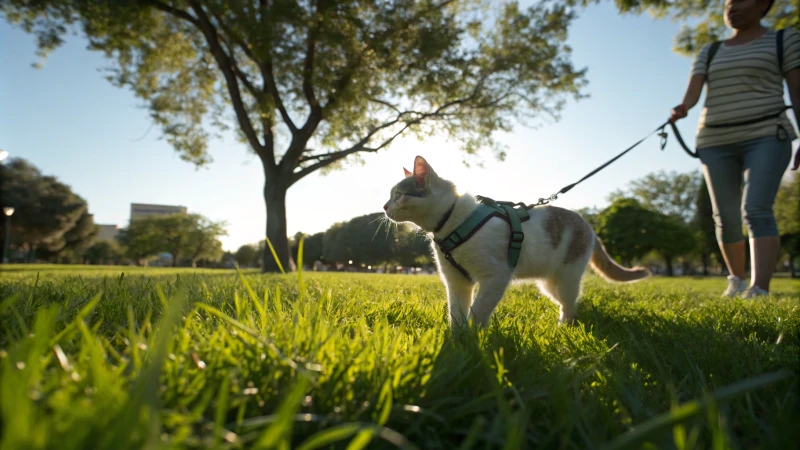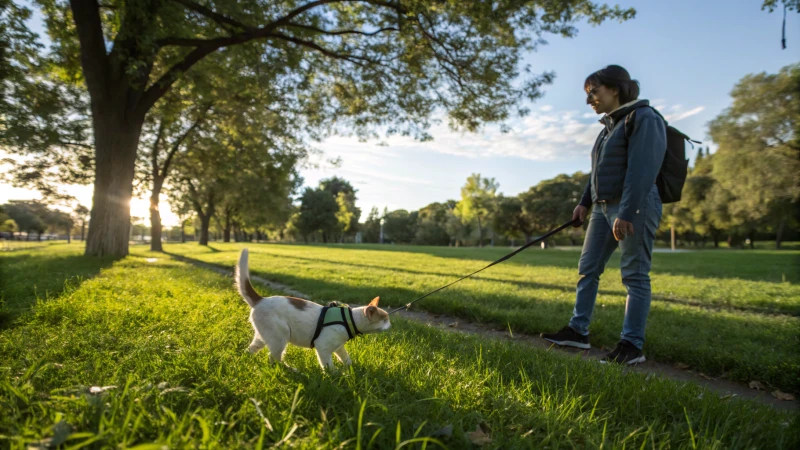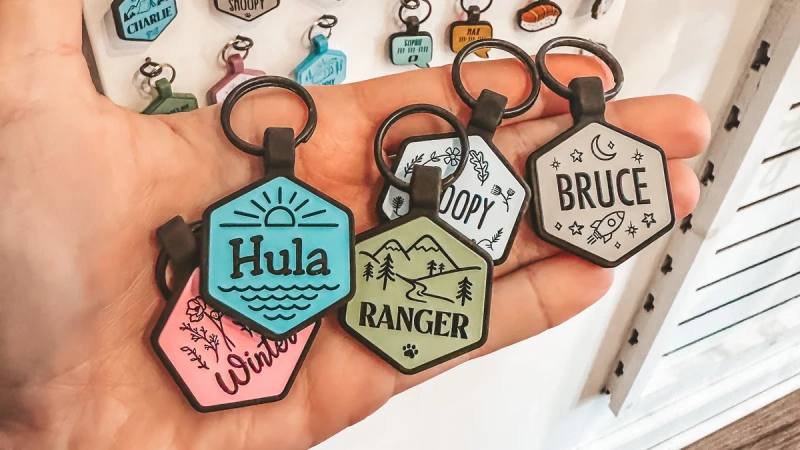
Many people wonder whether a collar or a harness is safer for walking their cat. You’re not alone in this question!
Veterinarians and trainers suggest using a harness when walking cats instead of a collar. Harnesses spread pressure evenly on the body. They reduce the risk of choking. Harnesses are the best choice for training your cat to walk on a leash.
When I first considered walking my cat, I felt unsure about which choice to pick. I talked with veterinarians and trainers. They said that using a harness is the best choice. Harnesses offer more control. They keep cats safe and comfortable. My furry friend can explore without the danger of choking. This thought gives great peace of mind. Let’s see what experts say about safely walking cats.
Harnesses are safer than collars for walking cats.True
Veterinarians recommend harnesses over collars due to safety and comfort, reducing choking risks.
Cats can be effectively leash trained with a collar.False
Using a collar for leash training can lead to choking hazards, making it less effective than harnesses.
Why Should I Choose a Harness Over a Collar for My Dog’s Safety?
I am a proud dog parent who has devoted a lot of time to finding the top gear for my furry friend. I researched and learned from personal experience to choose the right items. Harnesses provide great safety benefits. Collars do not provide the same protection. Harnesses are the best option for dogs!
Harnesses are safer than collars for dogs. They spread pressure across the chest. This distribution decreases the risk of escape. Harnesses also offer better control. This control helps prevent possible injuries during walks. Walks become safer and more enjoyable for dogs.

Safety and Comfort
I think about my dog’s safety often. Harnesses come to mind right away. Unlike collars, which push against a dog’s neck, harnesses spread the pressure across the chest and shoulders. This is crucial for my lively dog. He loves to chase squirrels! I remember the first time he dashed after one; the leash pulled him forward. Luckily, his harness kept him safe and he didn’t risk choking.
Better Control
Harnesses offer me much better control during walks. With the leash connected to the harness, I can guide him without straining his neck. This is really important for bigger dogs or those that pull, like my eager golden retriever! I read a study about this that noted dogs on harnesses often walk more calmly and escape less than those with collars. For more detailed studies on this, check out pet training tips1.
Reduced Risk of Escape
Harnesses also really help prevent escapes. Many collars can easily slip off if a dog pulls or rolls around, especially breakaway types designed to avoid choking hazards. A friend told me a story last week about their cat escaping its collar on a walk. Thankfully, harnesses fit better and scary moments happen less frequently with them. With a harness, I feel confident knowing my dog stays snugly secured and can’t wiggle free.
| Feature | Collar | Harness |
|---|---|---|
| Risk of Escape | High (especially breakaway types) | Low (secure fit) |
| Pressure Distribution | Neck only | Chest and shoulders |
| Injury Potential | High (choking hazards) | Low (better control) |
Types of Harnesses
I found several types of harnesses while shopping:
- Vest Harnesses: These fit snugly on the chest and neck, spreading pressure evenly; they are my first choice!
- H-Style Harnesses: These offer more movement freedom but may press on the throat if a dog pulls.
- Figure-8 Harnesses: These look like vest harnesses but have designs that help spread pressure equally.
Each type has special features suitable for different breeds and personalities. For more advice on choosing the right harness, see harness selection guide.
I truly believe harnesses are the best for walking my dog as they provide more control, comfort, and safety than collars do. Buying a high-quality harness was one of my best decisions for my dog’s well-being.
Harnesses reduce choking hazards compared to collars.True
Harnesses distribute pressure across the chest, minimizing choking risks during sudden pulls or lunges, unlike collars that apply pressure solely on the neck.
Collars provide better control than harnesses for large dogs.False
Harnesses offer superior control over larger dogs, reducing neck strain and escape risks, making them safer than collars for such breeds.
How do I choose the right harness for my cat?
Finding the best harness for my cat has been quite an adventure! I want them to be safe and comfortable while exploring outside. Here are some helpful tips that guided me!
Consider your cat’s size and behavior when selecting the right harness. A snug-fitting harness is important. It distributes pressure evenly. Avoid using collars for walks. Measure your cat’s neck and chest accurately. Explore styles like vest harnesses and H-style harnesses. Choose the one that fits best.

Understanding the Importance of a Harness
Selecting the best harness for your cat is about keeping them safe and comfortable, not just about fashion. I learned this lesson when I wanted my curious cat, Whiskers, to explore the outdoors. Harnesses spread pressure more evenly across a cat’s body than collars. Collars might choke or harm them if they pull hard. My adventurous Whiskers needed something that kept him secure while he explored.
I remember the first time Whiskers wore a collar that didn’t fit well. He squirmed, yanked and I worried he might escape or get hurt. Switching to a harness changed everything! It reduced choking risks. My little escape artist stayed safe during walks. Trust me, harnesses really improve comfort and give peace of mind.
Types of Harnesses to Consider
Many types of harnesses surprised me when I began my research! Here’s a quick overview of some useful options:
| Type of Harness | Description | Best For |
|---|---|---|
| Vest Harness | Snug fit around chest, distributes pressure evenly. | Cats that prefer comfort. |
| H-Style Harness | Allows freedom of movement but may apply pressure on the throat when pulling. | Active cats that don’t pull hard. |
| Figure-8 Harness | Similar to vest but with a different design; also distributes pressure evenly. | Cats that require a secure fit. |
Each type has advantages, so consider your cat’s behavior. For instance, cats that pull (like Whiskers) may find a vest harness more comfortable as it spreads pressure evenly across the chest.
Measuring Your Cat for the Perfect Fit
Before buying a harness, I measured Whiskers carefully. Here’s what I did:
- Neck Circumference: Measured around the widest neck part.
- Chest Girth: Wrapped the tape behind the front legs.
- Length: Measured from neck base to tail base for length guidance.
These measurements were important for a snug, comfy fit and really mattered for keeping Whiskers secure! For more detailed instructions, see our guide on measuring your cat for a harness2.
Tips for Introducing Your Cat to a Harness
Introducing a harness can seem daunting, but I found the following strategies helpful:
- Start Slow: Letting my cat sniff and touch the harness first eased the process.
- Positive Reinforcement: Treats and praise worked well to encourage Whiskers when he wore the harness; he turned it into a fun time!
- Short Sessions: Initially limited harness-wearing time helped avoid overwhelming him.
These tips made our harness adventures fun for both of us! If you want more guidance, explore our article on getting your cat used to a harness3.
Common Mistakes to Avoid
In my learning journey, I found common mistakes pet owners often make:
- Choosing the Wrong Size: A poor-fitting harness causes discomfort and might let your cat escape.
- Ignoring Your Cat’s Behavior: If distress occurs, try another style or size.
- Using Collars for Walking: Use collars for identification only; harnesses are best for walks!
Avoiding these mistakes has really helped Whiskers and me. I hope these insights also benefit you on your adventures!
A properly fitted harness reduces choking hazards for cats.True
Harnesses distribute pressure evenly, minimizing the risk of choking during walks, making them safer than collars.
Collars are recommended for walking cats instead of harnesses.False
Collars can easily slip off and are not safe for walking; harnesses provide better security and comfort.
What Types of Harnesses Are Available for Cats?
Finding the right harness for my cat felt like a journey. Many pet owners probably have the same experience. Outdoor adventures should be safe and fun for pets. Different types of harnesses exist for this purpose. These harnesses keep your cat secure while exploring outside. Enjoy the great outdoors with your feline friend safely.
When thinking about a harness for your cat, you have vest, H-style and Figure-8 choices. Each kind provides different advantages. They really help keep your cat safe and comfortable during walks. Safety is really important.

Understanding Harness Types for Cats
When I first walked with my cat, Whiskers, I noticed the need for a good harness. A harness keeps our pets safe. It also offers comfort that collars lack. Here is what I learned about different harnesses:
| Type | Description | Best For |
|---|---|---|
| Vest Harness | A snug fit around the chest, distributing pressure evenly across the body. | Active cats and skittish cats needing comfort during walks. |
| H-Style Harness | Allows freedom of movement but can exert pressure on the throat if the cat pulls. | Adventurous cats who enjoy exploring but may pull on the leash. |
| Figure-8 Harness | Similar to vest harnesses but with a different design that helps distribute pressure evenly. | Cats needing a balance of comfort and flexibility. |
Vest Harnesses
Vest harnesses feel very soothing to Whiskers. They cover the chest and neck, providing a warm embrace and spreading pressure evenly. This design is excellent for:
- Active Cats: Cats that love to sprint and explore benefit from this even pressure as it avoids unwanted stress.
- Skittish Cats: It offers a tight fit which probably makes them feel secure outdoors, wrapped with love.
Discover more about vest harness options4 for your cat.
H-Style Harnesses
When Whiskers used an H-style harness, I was surprised by his freedom! This harness has two adjustable straps meeting at the back, providing:
- Freedom of Movement: Your cat can move happily without feeling confined.
- Adjustability: It fits your cat’s body shape well; however, watch their pulling though – this harness presses on their throat if they pull hard.
Look into various H-style harness features for adventurous cats.
Figure-8 Harnesses
The Figure-8 harness was another choice I tried. It mixes vest and H-style designs. Here’s what I enjoyed about it:
- Even Pressure Distribution: It reduces stress on the neck, making walks more comfortable.
- Simple Adjustability: Easy to adjust straps offer a snug fit, ideal for wiggly cats!
Check out Figure-8 harness benefits to see if it suits your pet.
Conclusion
Picking the right harness for my cat depended on his needs and likes. Many types exist, each with special benefits for different cats. Choosing wisely keeps your pet safe and comfy outdoors. Enjoy these shared exploration moments; they create cherished memories!
Vest harnesses provide stability for skittish cats.True
Vest harnesses wrap snugly around a cat's chest, offering support and comfort, which is especially beneficial for skittish cats during walks.
H-style harnesses restrict movement more than vest harnesses.False
H-style harnesses allow greater freedom of movement compared to vest harnesses, making them suitable for active cats that enjoy exploring.
What Are the Best Tips for Walking My Cat Safely?
Walking my cat has been one of the most rewarding parts of having a pet! It brings joy and happiness. Cat safety and comfort are crucial. Here are some heartfelt tips I’ve gathered on this journey that might help you too!
Use a safe harness for walking your cat. Avoid a collar. Introduce leash training slowly inside the house. Watch your cat’s behavior closely outdoors. Repeat training sessions often. Positive rewards keep training effective.

Choosing the Right Equipment
When I first wanted to walk my cat, I knew picking the right harness was crucial for our adventures. Initially, I thought a collar would do, but I soon found out that harnesses are safer. They spread the pressure over my cat’s body and help prevent injuries, especially if she pulls too hard. This is very important.
There are various types of harnesses:
| Harness Type | Description | Safety Features |
|---|---|---|
| Vest Harness | Fits snugly around the chest and neck, offering even pressure. | Reduces choking risk, comfortable for most cats. |
| H-Style Harness | Allows freedom of movement but may cause throat pressure. | Secure fit, but monitor pulling behavior. |
| Figure-8 Harness | Similar to vest but with a unique design for pressure distribution. | Balances comfort and security effectively. |
I measured my cat’s girth and neck multiple times to get the perfect fit. This prevented any chance of her escaping during walks! The fit was crucial.
Gradual Introduction to Leash Training
Starting leash training was really exciting! I began by letting my cat wear the harness inside the house for short times. The first time she wore it, she gave me a puzzled look! But slowly, she became used to it and it turned into a fun routine.
Here is my method:
- Familiarization: I allowed my cat to sniff and check out the harness first. This made her feel more comfortable.
- Short Wear Sessions: After a few days, I put the harness on her for 5-10 minutes and gave her treats. The treats were really effective!
- Attach the Leash: Once she seemed calm with the harness, I attached the leash and followed her around the house. It felt like a mini adventure!
Patience was very important here; I never hurried the process!
Outdoor Safety Measures
When we finally went outside, I felt both excited and a bit worried. New sights and sounds awaited my cat outdoors.
Some safety measures I followed:
- Choose a Safe Environment: We began our outdoor walks in the backyard. This place felt safe and familiar to her.
- Monitor Behavior: I watched her reactions closely. If she seemed frightened, I guided us back indoors.
- Use Treats for Encouragement: Treats were a wonderful tool to encourage her calm behavior. They created positive associations with walks.
Creating a calm introduction was essential to help my cat feel secure while exploring. Security was the goal.
Regular Training Sessions
As we walked more, I included regular training sessions to encourage good behaviors. We enjoyed bonding during these times!
Here are some strategies I found effective:
- Short Walks: We began with 5-10 minute walks, then slowly increased the time as she grew more confident.
- Practice Commands: Teaching simple commands like “come” or “sit” kept her attentive and focused during walks.
- End on a Positive Note: Each session ended with praise or treats. This helped her link walks with positive experiences.
These strategies really helped build a great walking routine and made our bond stronger as companions.
A vest harness is safer than a collar for walking cats.True
Vest harnesses distribute pressure evenly, reducing choking risk compared to collars, making them safer for walking cats.
Cats should be rushed into outdoor leash training for best results.False
Rushing outdoor leash training can cause stress; gradual introduction is essential for a positive experience.
Conclusion
Harnesses are safer than collars for walking cats, providing better control and comfort while minimizing choking risks and escape potential.
-
Discover expert advice and recommendations on pet safety gear to make informed choices for your dog’s well-being. ↩
-
Explore expert advice on selecting a cat harness that prioritizes safety and comfort, ensuring an enjoyable outdoor experience for both you and your pet. ↩
-
Learn effective strategies for helping your cat adjust to wearing a harness, making walks more enjoyable. ↩
-
Understanding different harness types helps you choose the best option for your cat’s comfort and safety during walks. ↩



